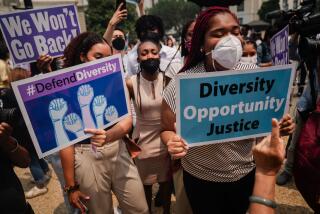Opinion: If Google doesn’t say why diversity is good, how can the fragile white men there grasp it?

By now you have probably heard of James Damore, the Google employee whom Google has now fired for circulating an internal memo that griped that Google created a “psychologically unsafe” place for men with conservative views like his.
If you are just tuning in, here are the highlights: Damore was especially vexed at Google’s various affirmative action initiatives, such as workshops that are limited to women or minorities. Damore didn’t call such practices affirmative action, though – he called them “discrimination,” which is a bit like telling a kid who needs glasses to read that he is “cheating.”
As a white male, Damore believes, in his own words, that affirmative action is “unfair, divisive, and bad for business.” In fact, Damore’s analysis was unfair, divisive, and bad for business, as others have already enumerated, but blaming him alone passes the buck: Google itself has never fully articulated why diversity is a desirable good, or how it will achieve it. In the absence of such leadership, no wonder one employee went off the rails.
Nowhere on the site does Google define what a better discussion, decision, or outcome is, or explain how diversity achieves that.
Google’s diversity problem is longstanding, but my critique begins in 2014. That is when Google, after much reluctance, published its diversity numbers for the first time, spurring a number of programs designed to move the needle on them, such as:
- Training on unconscious bias (one of Damore’s favorite targets)
- Recruiting from places like historically black colleges and universities
- Allowing employees to spend up a fifth of their paid time working on personal projects to increase diversity within Google
Notably, as Ellen McGirt observed for Fortune magazine, Google’s diversity campaign never came with an official, top-down directive. Larry Page, Alphabet CEO and Google co-founder, for example, did not issue a memo, according to McGirt.
The closest thing to a vision statement might be on Google’s diversity page, where CEO Sundar Pichai is quoted saying, “A diverse mix of voices leads to better discussions, decisions, and outcomes for everyone.”
Nowhere on the site, however, does Google define what a better discussion, decision, or outcome is, or explain how diversity achieves that.
There are a number of ways we can speculate. It might be the case that Google believes diversity:
- Leads to better user experiences. Google’s employees don’t look much like Google’s users. Diversity could solve that, leading to better optimization.
- Would have prevented various appalling situations, such as facial-recognition technology that incorrectly tagged black people’s faces as gorillas’.
- Helps employees solve problems faster. In one study, researchers found that racially diverse groups of undergraduates solved a murder mystery faster than homogenous groups because they expected people unlike them would have different information and perspectives, which they did.
- Advances social justice. As one of the most powerful companies in the world, Google may simply wish to use its immense influence to stand up for certain values, such as equality of outcome.
Unfortunately we may never know why Google really cares about diversity, which affects our ability to evaluate its methods. Even after the Damore bombshell, Danielle Brown, Google’s new vice president for diversity, integrity and governance, resorted to bromides. “Diversity and inclusion are a fundamental part of our values and the culture we continue to cultivate,” she said in her condemnation of Damore’s statement. “We are unequivocal in our belief that diversity and inclusion are critical to our success as a company, and we’ll continue to stand for that and be committed to it for the long haul.”
Nice words, but what do they mean? As a former teacher, I get some of Damore’s frustration, and confusion. “We’re told by senior leadership that what we’re doing is both the morally and economically correct thing to do, but without evidence this is just veiled left ideology that can irreparably harm Google,” he wrote.
On this singular point, Damore is right: If he does not understand the purpose of Google’s diversity programs, or their results, how can he be sure they are working, and are worth his discomfort? To avoid situations like these, and truly be an industry leader, Google needs to do what every teacher does in her sleep and backwards-plan a diversity policy from the top down, so the whole company knows Larry Page is serious. The concept of backwards planning is not exclusive to education, and should be familiar to any design-thinker at Google:
Step 1. Write a measurable objective
Step 2. Write the test you will use to determine if you achieved it
Step 3. Design the lesson/program based on the test
Step 4. Deliver
Step 5. Measure
Step 6. Communicate results
Step 7. Rework and repeat Step 3 and 4 as needed, until satisfied with Step 5.
Google’s problem is neither one irate employee, nor an echo chamber. It’s that its leaders either don’t know why they care about diversity, or they don’t know how to track and report it. Somehow I find it hard to believe the world’s greatest data whiz is struggling with the latter.
Cassady Rosenblum is an intern in The Times’ Opinion department.
Follow the Opinion section on Twitter @latimesopinion or Facebook
More to Read
A cure for the common opinion
Get thought-provoking perspectives with our weekly newsletter.
You may occasionally receive promotional content from the Los Angeles Times.










